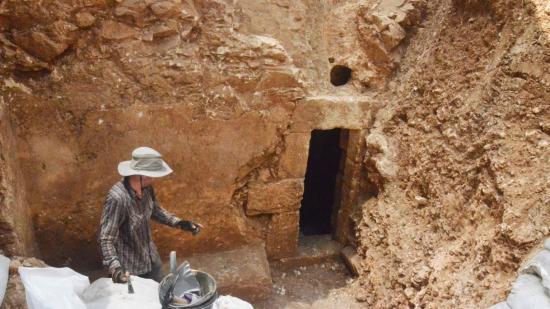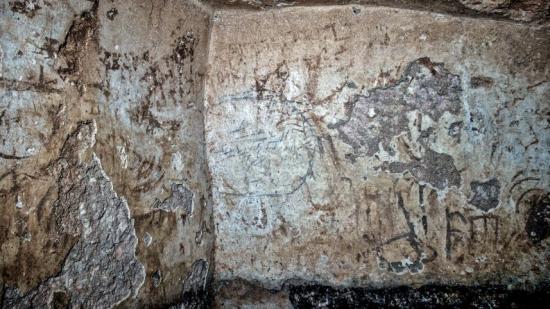Second Temple-era ritual bath found after a stone suddenly vanished into an unknown underground cave. The 2,000-year old writing also began to vanish the second it was exposed
Nir Hasson and Ruth Schuster / Photos: Shai Halevy, courtesy of the Israel Antiquities Authority
Source - http://www.haaretz.com/beta/1.669678
 An ancient ritual bath plastered in ancient graffiti from the Second Temple era has been found while ahead of digging the foundations for a new nursery school in the Jerusalem neighborhood of Arnona.
An ancient ritual bath plastered in ancient graffiti from the Second Temple era has been found while ahead of digging the foundations for a new nursery school in the Jerusalem neighborhood of Arnona.
Ritual baths from that period are not rare in the Holy Land, but they don't usually feature time capsules in the form of writing and symbols. The space is highly unusual in featuring inscriptions in ancient Aramaic – albeit pretty much incomprehensible - on the plastered walls.
The writing and painting was done in mud and soot, and some carved into the soft stone. There are also dozens of images including a boat, palm trees and various plant species, and possibly even a menorah, says Re'em.
 Examples of written Aramaic from the time of the Second Temple are very rare. The use of Aramaic on the walls suggess that it was the common language of the time, which could strengthen the argument that Jesus spoke Aramaic, as opposed to Hebrew.
Examples of written Aramaic from the time of the Second Temple are very rare. The use of Aramaic on the walls suggess that it was the common language of the time, which could strengthen the argument that Jesus spoke Aramaic, as opposed to Hebrew.
By the way, there is certainly one other example of a Jerusalemite mikveh from the Second Temple age with graffiti all over it. That case however involved rather pedantic Australian soldiers from World War II, who carved their names and identity numbers into the ancient walls.
This latest discovery of the 2,000-year old bathing chamber, carved into the stone of a natural cave, was serendipitous.
Given that Israel is the birthplace of, it seems, not only the three great religions but modern mankind as well, it is a hotbed of archaeology. Every time any construction project starts, be it of a new nursery school or road, the Israel Antiquities Authority carries out a "salvage excavation" – it checks whether there are ruins there that need preservation.
 This time, in the very last hour of the very last day of the salvage dig, a stone suddenly vanished – into a black hole. Thus the underground space was revealed, says IAA Jerusalem manager Amit Re'em.
This time, in the very last hour of the very last day of the salvage dig, a stone suddenly vanished – into a black hole. Thus the underground space was revealed, says IAA Jerusalem manager Amit Re'em.
But to the horror of the archaeologists, within hours of the momentous discovery, the writing started to fade.
Emergency archaeology conservation teams from the IAA were alerted. The plaster was removed for study at the IAA labs and the delicate finds have been sealed.
The underground bath was accessed by a stone staircase and an anteroom flanked by benches. A winepress was excavated alongside the ritual bath, the IAA says.
Just a month ago a family in another Jerusalem neighborhood admitted to having discovered a mikveh from the same time, roughly 2,000 years ago, below their living room. (The family had found the underground bath some years before, but had waited to report their discovery.)
Cohen woz 'ere?
Finding a decently-preserved concentration of inscriptions and symbols from the Second Temple period is rare, the IAA notes, while admitting in the same breath – see the pictures – that the writing is not legible any more.
Some of the inscriptions might indicate names. Or they might not. One word might be the name "Cohen," suggests Prof. Hagai Misgav of the Hebrew University of Jerusalem. Another word looks like it might be "avad" (as in "served" - e.g., served the Lord, not "worked").
"The symbols we see are familiar to us from coins, sarcophagi and graves, but a concentration like this is certainly unusual," Re'em said. "It is possible that writing on mikveh walls was common, but was not usually preserved."
At this point the archaeologists have no theory as to who wrote and carved the words and images, or if there was a message the artist wanted to convey.
While the symbols that can be discerned are common elements in the visual arts of the Second Temple period, says the IAA – it adds that the drawing that might possibly be construed as a menorah is exceptional because back then, it was taboo to portray this sacred object located in the Temple.